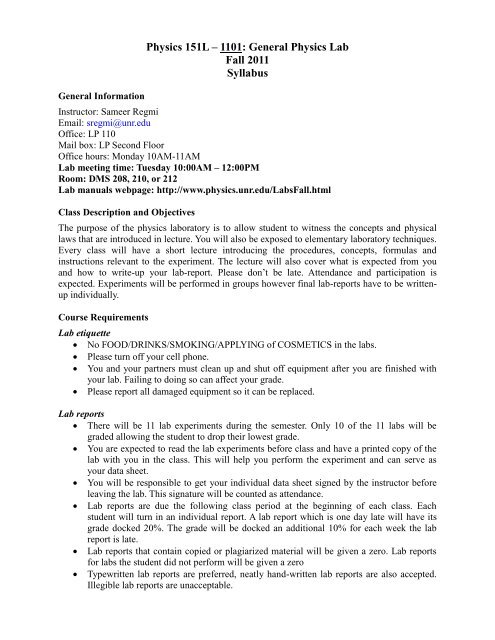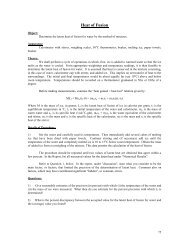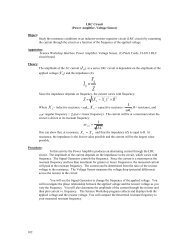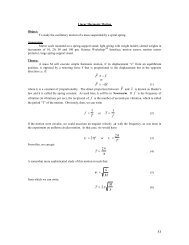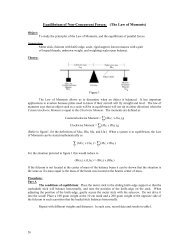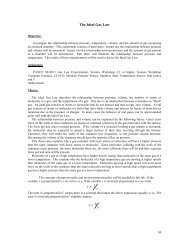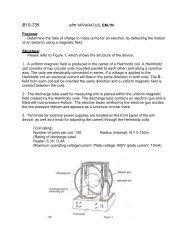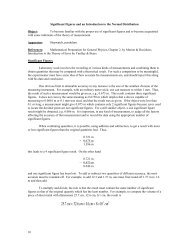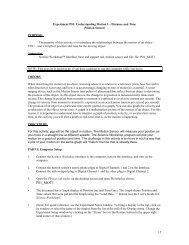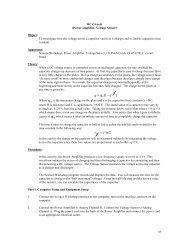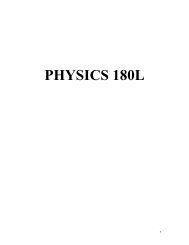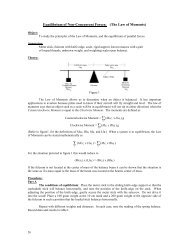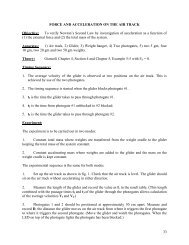Physics 151L – 1101: General Physics Lab Fall 2011 Syllabus
Physics 151L – 1101: General Physics Lab Fall 2011 Syllabus
Physics 151L – 1101: General Physics Lab Fall 2011 Syllabus
Create successful ePaper yourself
Turn your PDF publications into a flip-book with our unique Google optimized e-Paper software.
<strong>General</strong> Information<strong>Physics</strong> <strong>151L</strong> <strong>–</strong> <strong>1101</strong>: <strong>General</strong> <strong>Physics</strong> <strong>Lab</strong><strong>Fall</strong> <strong>2011</strong><strong>Syllabus</strong>Instructor: Sameer RegmiEmail: sregmi@unr.eduOffice: LP 110Mail box: LP Second FloorOffice hours: Monday 10AM-11AM<strong>Lab</strong> meeting time: Tuesday 10:00AM <strong>–</strong> 12:00PMRoom: DMS 208, 210, or 212<strong>Lab</strong> manuals webpage: http://www.physics.unr.edu/<strong>Lab</strong>s<strong>Fall</strong>.htmlClass Description and ObjectivesThe purpose of the physics laboratory is to allow student to witness the concepts and physicallaws that are introduced in lecture. You will also be exposed to elementary laboratory techniques.Every class will have a short lecture introducing the procedures, concepts, formulas andinstructions relevant to the experiment. The lecture will also cover what is expected from youand how to write-up your lab-report. Please don’t be late. Attendance and participation isexpected. Experiments will be performed in groups however final lab-reports have to be writtenupindividually.Course Requirements<strong>Lab</strong> etiquette No FOOD/DRINKS/SMOKING/APPLYING of COSMETICS in the labs. Please turn off your cell phone. You and your partners must clean up and shut off equipment after you are finished withyour lab. Failing to doing so can affect your grade. Please report all damaged equipment so it can be replaced.<strong>Lab</strong> reports There will be 11 lab experiments during the semester. Only 10 of the 11 labs will begraded allowing the student to drop their lowest grade. You are expected to read the lab experiments before class and have a printed copy of thelab with you in the class. This will help you perform the experiment and can serve asyour data sheet. You will be responsible to get your individual data sheet signed by the instructor beforeleaving the lab. This signature will be counted as attendance. <strong>Lab</strong> reports are due the following class period at the beginning of each class. Eachstudent will turn in an individual report. A lab report which is one day late will have itsgrade docked 20%. The grade will be docked an additional 10% for each week the labreport is late. <strong>Lab</strong> reports that contain copied or plagiarized material will be given a zero. <strong>Lab</strong> reportsfor labs the student did not perform will be given a zero Typewritten lab reports are preferred, neatly hand-written lab reports are also accepted.Illegible lab reports are unacceptable.
You can turn in graphs on graph paper or printed out. Hand-drawn graphs on anythingother than graph papers are unacceptable.Please follow the given format for the lab write-ups. This format can be found at the labmanual website.AttendanceYou are required to attend all the classes. If you must miss a lab due to an excused absences(illness, emergency or pre-arranged absence), you should arrange to make up the lab during adifferent lab session that week (the week of your absence). You should contact both instructorsbefore attending another lab section. No more than two labs can be done in other lab sections. Bydepartment rules, if you miss three or more classes you will receive a failing grade for the labsection. There is no way to make up the labs. <strong>Lab</strong> reports that are turned in for experimentswhich you did not attend/perform will not be graded. You are expected to be to class on time.<strong>Lab</strong>oratory safetyExperimental work can exposure one to various kinds of hazards (electric shock, burns, cuts…),every person working in the laboratory should be situational aware of their surroundings so as toavoid possible injury. Be aware and reduce the risk of injury and/or damaging the equipment.Report any accident immediately.Grading and total percentage of reports:90 or above A80 <strong>–</strong> 89 B70 <strong>–</strong> 79 C60 <strong>–</strong> 69 DBelow 60 FIn borderline cases +/- grades can be assigned.Disability Services: Any student wishing to apply for academic accommodations or adjustmentsis requested to inform the instructor, or contact the Disability Resource Center (DRC, Thompson,Suite 101, phone 784-6000) directly, as soon as possible to arrange appropriate actions. The DRCwill be able to answer any questions regarding accommodations or adjustments.Academic Success Services: Your student fees cover usage of the Math Center (784-443 orwww.unr.edu/mathcenter/ ), Tutoring Center (784-6801 or www.unr.edu/tutoring/ ), andUniversity Writing Center (784-6030 or www. unr.edu/ writing_center ). These centers supportyour classroom learning; it is your responsibility to take advantage of their services. Keep inmind that seeking help outside of class is the sign a responsible and successful student.Academic Integrity: All lab reports, homework, or exams must be your own work. Any act ofplagiarism (cheating, piracy, theft, etc.) or otherwise obtaining grades under false pretensesconstitute academic dishonesty according to the code of this university. Academic dishonestywill not be tolerated and penalties can include canceling a student's enrollment without a grade,giving an F for the course or for the assignment. For more details, see the UNR <strong>General</strong> Catalog.
Format of <strong>Lab</strong> Reports and Grading <strong>Fall</strong> <strong>2011</strong>Name:<strong>Lab</strong> Partners Name:<strong>Lab</strong> Section:Date of Experiment:Title of the Experiment(1 point for having a title)Abstract (5): A concise statement (a paragraph or two) that summarizes the objective,in your own words, and states the numerical results of the experiment, worth a total of 5points.1 point for having an abstract2 points for summarizing objectives2 points summarizing resultsTheory (10): Summarize in your own words, the theory of the physics involved in theexperiment. Also present the working equations, units and a schematic of the experimentalapparatus. The theory sections should also outline the procedures used in the lab, worth a totalof 10 points.3 points for outlining procedures2 points for outlining theory2 points for diagramming setup1 points for stating proper units1 points for expressing relevant equations1 points for defining and explaining relevant termsData (6): An orderly display of the data, preferably in tabular from. You must including theoriginal data sheet signed by the TA. All entries should be clearly identified and include theirproper units, worth a total of 8 points.2 points for a data section2 points for proper/clear labeling of data2 points for proper units of dataAnalysis (14/lab dependent): Must clearly show the computations used to reduce the data. Firstwrite the relevant equations then give a sample calculation. Be sure to includeproper units and use the correct number of significant figures.2 points for having an analysis section2 points for displaying relevant formula2 points for sample computation2 points for proper units2 points for significant figuresGraphs: 2 points proper units2 points labeling axis
Results and conclusion (12):A brief Summary of your results, stating the determined value or law, along with its numericaluncertainty. Use proper units and significant figures. For example, the experimental value for “g”was found to be:Acceleration of gravity g = (9.8 0.2) m/s 2Frequently you will want to compare your result (F) with an accepted value (F o ). A goodquantity to compute in this case is the “percent discrepancy” or the “Percent error” which isdefined as:Percent Discrepency F FF00100%If you are comparing two values of “F” found in different ways (F 1 and F 2 ) find the “percentdifference” given by:Percent Difference F F1 2F M100%Where F M is the mean of F 1 and F 2 . Round off percent errors and differences to two significantfigures. Discuss what you found and compare with what you had expected to find. Discuss anydiscrepancies. One may suggest ways in which to improve the experiment or reduce errors. Somelabs may include questions, worth a total of 12 points.2 points for having a results section2 points stating determined value2 points for stating uncertainty2 points for having a discussion section2 points for summarizing experiment and results2 points for each question answered correctlyGrade = (total points earned / total point available) X 100Note: Your instructor will consider the above format important when grading your lab report. Thefollowing will be considered important in grading your reports (in addition to the physics):1. Neatness2. Composition3. Grammar4. Thought/Originality in presentation5. SpellingBonus point will be given for finding and reporting errors in lab manual. Not all labs will conformexactly to the lab report format, given above. Some labs may not require a certain section of the labformat. While another lab may require an additional section be added to the write-up. For nonconforminglabs, check with the instructor as to what they expect for a write up.


